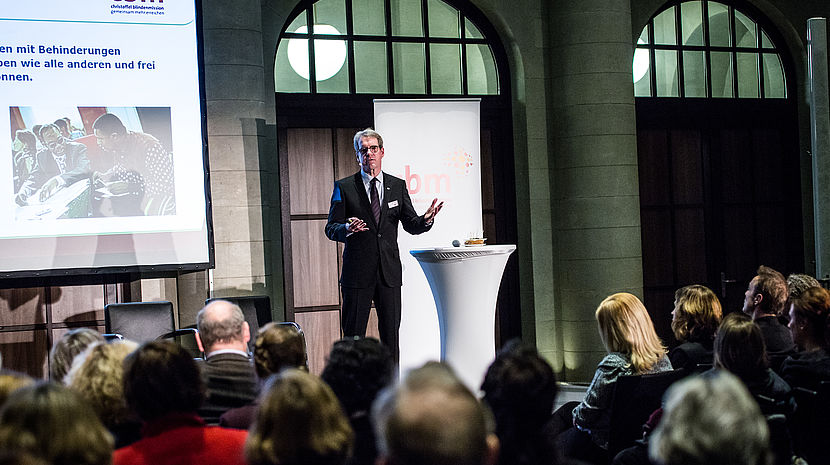2 years since adoption of the SDGs

Dr. Rainer Brockhaus (CEO of CBM Germany and Chairman of the leadership team at CBM International) during a podium discussion on the 2030 agenda in Berlin on 3 December 2016.
A universal Agenda – in two years what has it delivered?
Today, 25 September 2017, is the second anniversary of the adoption of the landmark 2030 Agenda for Sustainable Development. This “was the first time in human history that we as human beings reached consensus on the future of development” as expressed by UN DESA’s Under-Secretary-General Wu Hongbo. The sentiment was that we could be the first generation to succeed in ending poverty everywhere.
For persons with disabilities, there was an unprecedented level of inclusion and representation with 11 explicit references in the Agenda, seven of which are found in the Sustainable Development Goals (SDGs). This represented a significant step forward for persons with disabilities in international development in contrast to the absence of references in the preceding Millennium Development Goals. We as CBM were key players in influencing governments to include persons with disabilities in the final Agenda.
What has happened since the adoption of this ambitious global agenda?
It is a must to look back and reflect on advances and remaining gaps.
Since the adoption, a global indicator framework on SDG indicators has been developed in which there are 11 explicit references to persons with disabilities and disability as well as the paragraph on disaggregation that includes disaggregation of data by disability. CBM has been active in the global indicator framework by participating in and/or contributing to all five meetings of the Inter-agency Expert Group on SDG Indicators (IAEG-SDGs) to ensure the inclusion of persons with disabilities. Additionally, CBM will also attend the upcoming sixth meeting of the IAEG-SDGs in November. Concurrently, the Sendai Framework for Disaster Risk Reduction indicators were developed and adopted on 2 February, 2017. “CBM was actively involved in this process with attending key meetings in Geneva, in order to ensure that the rights of persons with disabilities are included in the global indicators.” The Sendai indicators will measure global progress on reducing disaster losses and a revision of terminology related to disaster risk reduction, and are linked to the SDG indicator framework.
Persons with disabilities have been actively involved in the follow-up and review process of the 2030 Agenda, in particular at the High-level Political Forum with more than 50 participants with disabilities in attendance this year. Persons with disabilities have a leadership role in the coordination mechanism for other stakeholders for the HLPF. CBM has engaged with its partners in participating in and contributing to the HLPF processes, in particular in Bangladesh, Indonesia, and Togo. It is important that persons with disabilities continue to meaningfully participate in the format and organizational aspects of the HLPF, which will be reviewed during the 73rd session of the General Assembly by Member States.
In that regard, it is important to recall that the 2030 Agenda is meant to be a people-centered and driven process, truly of, by, and for the people. Keeping in line with the Agenda’s main tenant of “leave no one behind,” persons with disabilities are at the forefront and center of the process keeping with the spirit of disability movement’s theme of “nothing about us without us.” CBM will continue to play its part in making these two mottos a reality.